Fact:
On May 8, 2019, Taliban insurgents detonated an explosive-laden vehicle and then broke into American NGO Counterpart International’s offices in Kabul. At least seven people were killed and 24 were injured.
Following is the June 2021 installment of “ISIS Redux: The Central Syria Insurgency,” a monthly chronicle of attacks by the terrorist group ISIS in central Syria. Previous editions of ISIS Redux can be viewed through the following links: May, April, March, February, and January 2021; and December, November, October, September, August, July, June, May, and April 2020. A full background and analysis of ISIS’s resurgence in Syria, including its methodology, can also be explored here, here and here.
ISIS militants carried out at least 27 confirmed attacks in June, killing at least 24 pro-Assad regime fighters and one civilian, while wounding at least 59 others in the Homs, Deir Ez Zor, Raqqa, Hama, and Aleppo governorates. The number of ISIS attacks carried out rose slightly from May’s one-year low of 23 attacks, but remained below the average of +30 attacks per month that began in August 2020. Furthermore, high quality* attacks remained few and far between, with ISIS cells only conducting four in June, the lowest number since March 2020. The rise in general ISIS activity in June is solely due to a return of activity in Hama after an uncharacteristic low-activity period during May.
As in April and May, ISIS continued to shift its focus away from civilians. Only two attacks in June targeted civilians, compared to three attacks in May and five in April. Attack lethality dropped back to April levels in June after a brief increase in May. However, unlike in May, ISIS cells killed pro-regime commanders this month: a veteran Syrian Arab Army (SAA) brigadier general in Homs on June 3 and an Islamic Revolutionary Guard Corps (IRGC) commander in Deir Ez Zor on the same day. Both men were killed by mines/IEDs.
In fact, June saw the highest rate of mine/IED use by ISIS cells since the beginning of the insurgency, accounting for at least 17 of the 27 confirmed attacks. Almost all of the non-mine attacks occurred in Homs, while a sharp increase in Hama attacks was almost wholly attributable to mines. ISIS commonly reverts to a reliance on indirect attacks when under heavy pressure from security forces, as has been the case for the past four months. This increasing reliance on mines and the small number of high quality attacks in May and June suggests the organization continues to face difficulties reconstituting offensive actions due to sustained and widespread regime operations.
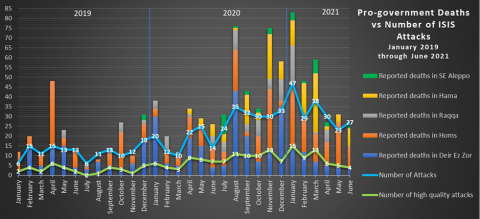
Attacks in June continued at roughly the pace of May and April in Homs (12), south Aleppo (1), and south Raqqa (1) while continuing their precipitous two month drop in Hama (4) and sixth-month drop in Deir Ez Zor (2). The main difference between May and June was the return to ‘normal’ levels of activity in east Hama (11) after a two month drop in April and May. As in April and May, June’s high quality attacks continued to be highest in Homs (2), but also occurred in Hama (1) and Deir Ez Zor (1).
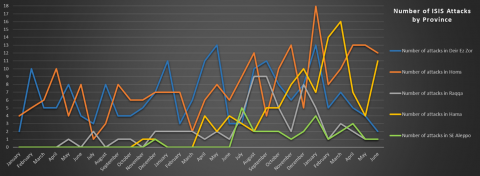
Hama
ISIS activity in east Hama rose sharply in June following a two-month decline. Eight of ISIS’s 11 attacks relied on mines or IEDs. ISIS officially claimed all but one of the mine/IED attacks. Despite being only the third highest number of attacks carried out in east Hama to date, the number of claimed attacks is both the greatest number claimed by the group in the province and the highest rate of claiming witnessed in any province in a single month. It is unclear to what extent the return of activity in east Hama is tied to the increase in claims there.
As in other parts of the Badia in June, many of the ISIS attacks in Hama could be categorized as “defensive”, i.e. cells using mines, IEDs, and small arms to harass patrols attempting to push into core ISIS territory. However, the first two days of June saw ISIS attempt to return to its late-2020 style of attacks. On June 1 militants fired on regime vehicles traveling on the Ithriyah highway, but caused only material damage. The next day, the group attempted to conduct a significant attack, targeting a regime outpost in the province. However, per ISIS’s own claim, the attack caused only material damage. This is in stark contrast to the outpost attacks the group conducted late in 2020 and early this year, when militants regularly seized such positions. The failure of the June 2 attack further speaks to the changing nature of the regime presence in the region.
ISIS then shifted to mines and IEDs, successfully carrying out some high casualty attacks. On June 8 and June 9, ISIS fighters hit regime convoys with at least three IEDs north of Rahjan, killing two soldiers and wounding 26 in total. Regime forces would attempt to reenter this area on June 18, but were stopped by small arms fire that left two soldiers wounded. On June 24, a bus carrying National Defence Forces (NDF) soldiers hit a mine or IED somewhere east of Salamiyah, leaving four dead and 11 wounded.
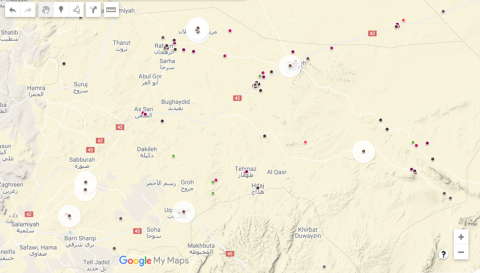
Map of ISIS attacks in Hama in June 2021 (highlighted dots). Not mapped are two additional attacks that ISIS claimed on June 1 and June 2 somewhere in “east Hama”.
Homs
ISIS activity in Homs remained high in June, continuing the trend began in late April. ISIS conducted 12 attacks in Homs, at least seven of which involved mines or IEDs. June’s attacks were concentrated in three areas: the Sukhnah and Palmyra countrysides, and Jabal Amor.
As in Hama, most of the Homs attacks were of very low quality. The most significant occurred on June 1, when an ISIS mine killed Brigadier General Nizar Fuhud. Fuhud was a veteran of desert warfare, having first arrived in Palmyra during the regime’s 2016 offensive. He had been commanding his own mukhabarat militia in the area and serving as the military advisor to the Sukhnah Sector commander at the time of his death.
The only significant small arms attack occurred on June 7 near the village of Baghlah, east of Sukhnah. According to local NDF, “serious” firefights went on for almost an hour before jets arrived and the ISIS fighters withdrew. It is unclear how many casualties each side sustained. One interesting attack occurred on June 19, when ISIS claimed to destroy a regime technical and a bulldozer near Sukhnah, later publishing pictures of both vehicles. Loyalist pages reported two soldiers killed in the area on the same day. It is likely that an ISIS cell targeted a small group of soldiers as they attempted to set up fortified positions somewhere on the forward edge of the ‘frontline’ around Sukhnah.
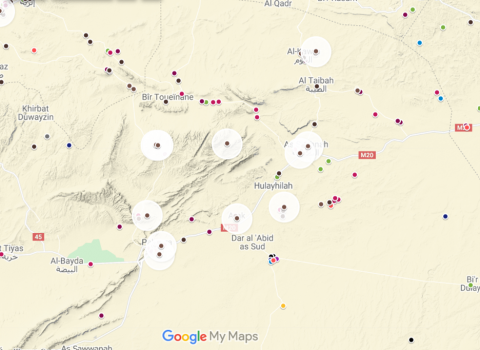
Map of ISIS attacks in Homs in June 2021 (highlighted dots). Not mapped are two additional attacks that together killed three soldiers and wounded another somewhere in the Homs countryside.
Deir Ez Zor
Attacks in Deir Ez Zor dropped to a record low of two in June, a level not seen since January 2019. However, one of these attacks led to the death of two IRGC personnel, including a commander, after their vehicle hit a mine on the Deir Ez Zor-Palmyra highway.
Raqqa and Aleppo
Confirmed ISIS activity in south Raqqa and Aleppo continue to fluctuate in the one to three attacks per month range. As in May, each governorate had one confirmed attack in June. On June 10, ISIS claimed to hit a regime vehicle with an IED near Khanasir, Aleppo, claiming to kill one and wound three. Loyalist pages reported the death of a 25th Division 1st Lieutenant in the area on the same day. On June 30, suspected ISIS militants fired on a bus carrying oil workers and security personnel as it left the Wadi Ubyad Oil Field south of Ghanem Ali. Three men were lightly injured. This was the first confirmed attack in this part of Raqqa since March 2020.
Regime Operations
There were no real changes in June to the widespread anti-ISIS operations carried out by the Syrian regime and its allies that began in January 2021. Operations in the Mayadin desert and the Jabal Bishri areas of Deir Ez Zor, heavily supported and/or led by the Iranians, continued and are clearly showing results. Meanwhile, fighters from the Shaytat tribe carried out patrols throughout the month in the Boukamal desert.
May’s operations around Kawm and Palmyra in Homs also continued in June. Regime forces continued to secure their supply lines to Kawm and gradually expanded the security zone around the town, while units from the SAA’s 11th Division began pushing into the mountains north of Palmyra. Both of these operations have been supported by the Syrian and Russian air forces, and the Palmyra sweeps have led to the discovery of several ISIS weapons caches.
Regime forces, mostly consisting of the 5th Corps, NDF, and 25th Division, increased patrols and sweeps in east Hama this month, especially around the Rahjan-Ithriyah corridor, and again swept the Ithriyah-Khanasir highway connecting Hama and Aleppo provinces.
Looking Ahead
The current anti-ISIS operations began in January 2021 following a four-month rapid increase in the severity and sophistication of attacks on security forces. Despite the operation, ISIS attacks persisted at their same high rate through March. Thus, the first quarter of 2021 had almost three times the confirmed number of ISIS attacks (112), high quality attacks (37), and deaths (189) compared with the first quarter of 2020 (42, 13, and 70) and four times as many (32, 8, and 43) as in the first quarter of 2019. However, unlike past anti-ISIS operations, Damascus and its allies did not back down, rather they increased the number of soldiers deployed and the frequency of air support.
In April, ISIS began to roll back its operations. The second quarter of 2021 saw 80 confirmed attacks, only a modest increase over the 61 attacks in Q2 of 2020. These attacks only left 83 soldiers and civilians dead, the same number ISIS killed in the month of January alone and slightly less than the number killed a year ago. Most significantly, ISIS carried out only 15 high quality attacks this quarter, compared to 24 last year and 12 in 2019.
ISIS forces in the Badia are now under the most pressure they have experienced since their insurgency began. They have lost much of the freedom of movement and operational space they enjoyed in 2020, most significantly in Deir Ez Zor. That being said, these are not as crucial to the Islamic State’s apparent goals in the Badia as they are in, for example, Iraq and northeast Syria. ISIS fighters may no longer be able to easily move around to conduct attacks, but as long as they can still blend in with the Internally Displaced Populations (IDP) and move across the Syrian Democratic Forces (SDF)-regime and regime-Iraq borders, ISIS can continue to use the Badia as a “rear base” for these other theaters.
Furthermore, while regime operations have been very successful at pushing ISIS cells deep into the mountains and desert, they have not led to the deaths or capture of anywhere near enough militants to put a long-term dent in the organization. Instead, according to ISIS analyst Mohammad Hassan, ISIS has been able to draw down its forces in the Badia and move fighters to Iraq and northeast Syria, where they currently face less pressure.
Regime operations will soon be facing the challenge of diminishing returns as the forward ISIS cells are all routed and forced deep into the empty portions of central Syria, which the regime can never fully clear. Once this is done, Damascus and its allies will have to continue setting up and supporting an extensive system of outposts and patrols in order to prevent “leakage” out of these remote ISIS concentrations. This process will require the near-permanent dedication of troops and resources, something that may be hard to justify once it is perceived that the ISIS threat was “dealt with”. This will likely be ISIS’s best chance to resurge without devoting extra resources of its own. Conversely, if coalition activity in Iraq and northeast Syria successfully pressures ISIS enough, the group may decide to withdraw fighters to the Badia and directly challenge the regime’s operations—as it did during the first three months of 2021.
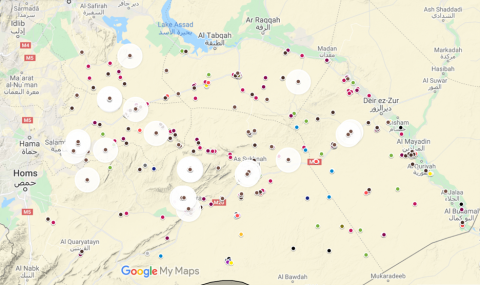
Map of locatable ISIS attacks (highlighted dots) in June 2021. This map does not include five attacks which did not have specific locations attributed to them; two “Hama countryside” attacks, two "Homs Badia" attacks, and one “Deir Ez Zor countryside” attack. To view an interactive version of this map, please click here.
---
*High quality attacks are defined as attacks behind frontlines, those that result in seized positions, target regime officers, involve coordinated attacks on multiple positions, fake checkpoints, ambushes on military convoys, or attacks on checkpoints that kill at least three soldiers or lead to POWs.
Extremists: Their Words. Their Actions.
Fact:
On May 8, 2019, Taliban insurgents detonated an explosive-laden vehicle and then broke into American NGO Counterpart International’s offices in Kabul. At least seven people were killed and 24 were injured.
Get the latest news on extremism and counter-extremism delivered to your inbox.